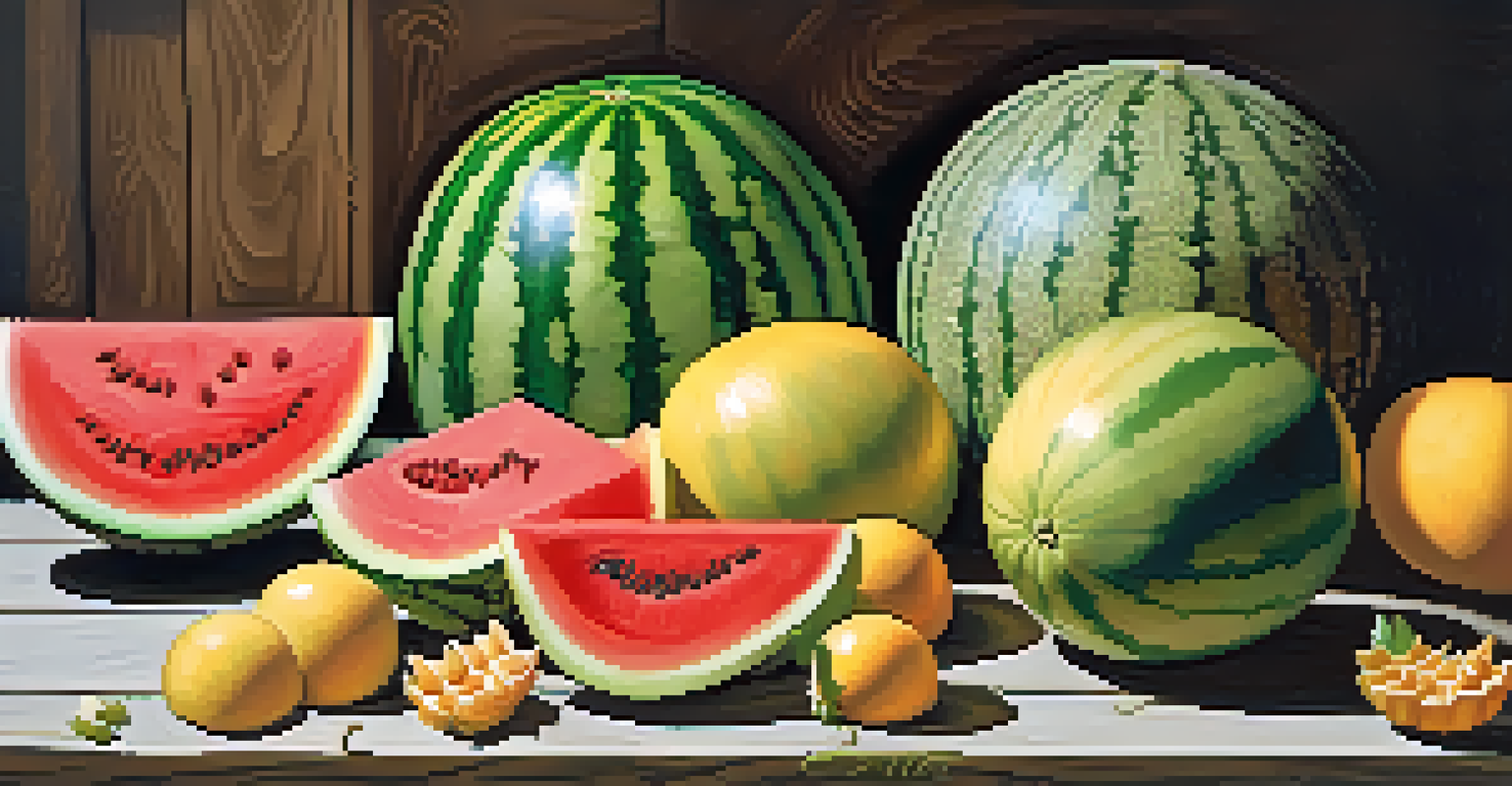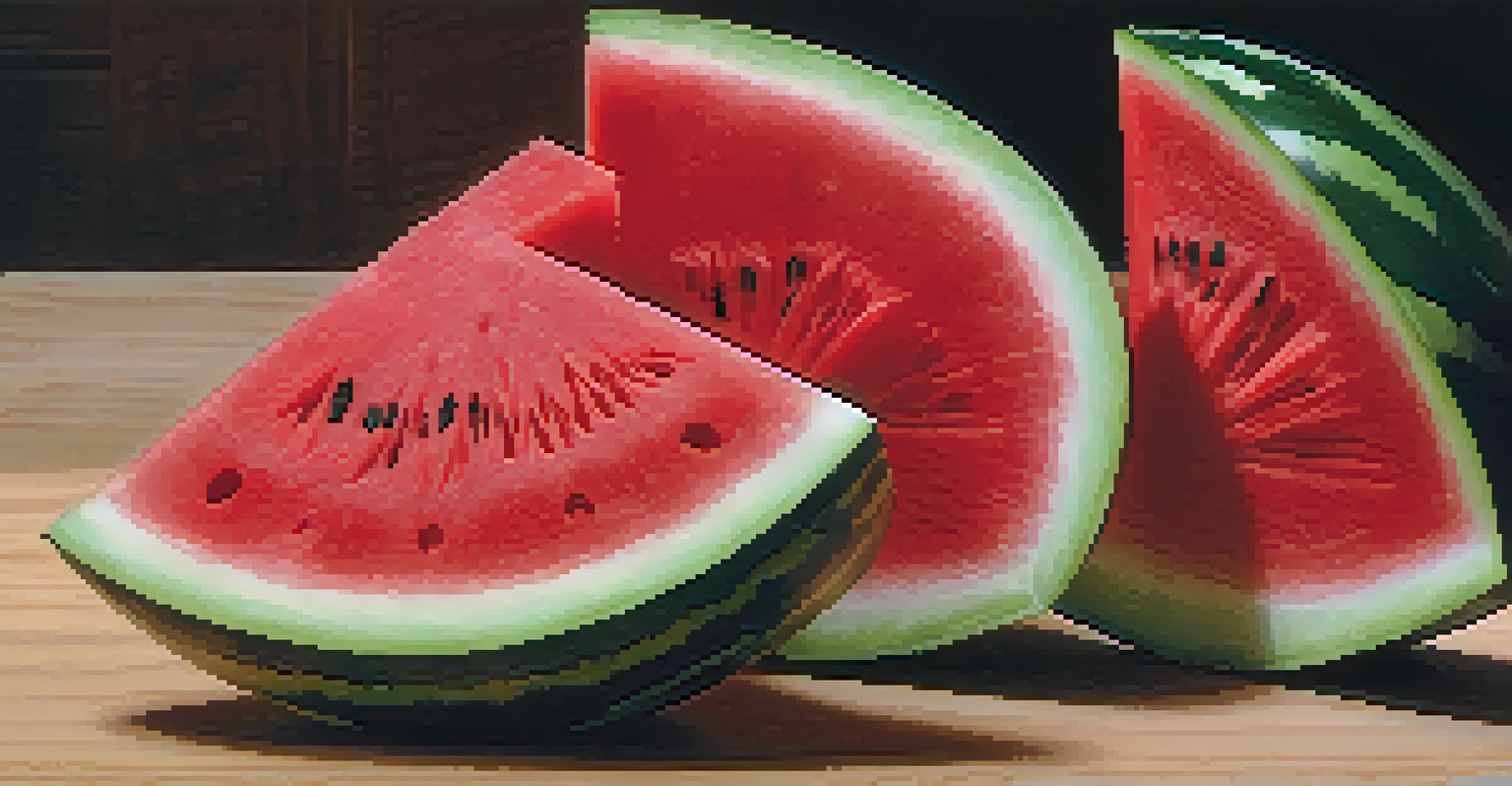Creative Techniques for Carving Melons into Stunning Centerpieces

Choosing the Right Melon for Your Masterpiece
When it comes to melon carving, selecting the right fruit is crucial. Watermelons and cantaloupes are popular choices, but don’t overlook honeydews or even pumpkins for unique designs. The key is to choose a melon that's ripe but firm, ensuring it holds its shape during the carving process.
Art is not what you see, but what you make others see.
Consider the size of the melon based on your event. A larger melon can serve as a stunning centerpiece, while smaller ones can be perfect for individual servings at a gathering. Each type offers different textures and colors, adding to the visual appeal.
Remember, a well-chosen melon not only enhances your design but also contributes to the overall taste of your dish. After all, a beautiful centerpiece should be as delicious as it is eye-catching!
Essential Tools for Melon Carving Success
To create stunning melon carvings, having the right tools is essential. A sharp paring knife, a melon baller, and a serrated knife can work wonders for your designs. If you're feeling adventurous, specialized carving tools can help you achieve intricate patterns.

Don't forget about safety—use a cutting board to stabilize your melon and protect your countertops. A sturdy grip is vital when working with slippery fruits, so consider using a towel underneath your cutting board for added traction.
Choose the Right Melon
Selecting a ripe, firm melon enhances both the design and taste of your carving masterpiece.
With the right tools in hand, you’ll find that your creativity can flow more freely. Investing in quality tools not only makes the process easier but also allows for more detailed and refined carvings.
Basic Techniques to Get You Started
Before diving into complex designs, it’s helpful to master some basic carving techniques. Start by practicing simple shapes like flowers, leaves, or geometric patterns. This foundational skill set will boost your confidence and prepare you for more intricate designs.
Creativity takes courage.
One popular technique is the 'V' cut, which can create beautiful petal effects. By angling your knife at 45 degrees, you can achieve depth and dimension in your carvings. Practice on scrap pieces to perfect your technique before moving on to your final melon.
As you progress, you'll find that combining these basic techniques allows for endless creative possibilities. Each new skill you acquire builds on the last, making the art of melon carving both rewarding and enjoyable.
Advanced Carving Techniques for Stunning Effects
Once you've mastered the basics, it’s time to explore advanced carving techniques. Techniques like overlay carving, where you create layers of designs, can add depth and intrigue to your centerpieces. This method allows you to combine multiple colors and textures for a truly unique look.
Another exciting technique is the use of negative space, where you carve away certain areas to create a design that pops out. This approach can give your piece a modern flair and draw the eye in unexpected ways.
Master Basic Carving Techniques
Practicing simple shapes builds confidence and prepares you for more intricate designs.
Experimenting with these advanced techniques can elevate your melon carvings from simple to spectacular. The more you practice, the more your confidence will grow, and soon you’ll be creating breathtaking edible art.
Color and Pattern: Enhancing Your Designs
Color plays a significant role in watermelon carving, as the contrast between the outer rind and the inner fruit can create striking visuals. Use the natural colors of the melon to your advantage, but also consider incorporating other fruits or vegetables to add pops of color.
Patterns can also enhance your designs, whether you choose classic motifs like paisleys or more playful designs like geometric shapes. Stencils can be helpful for beginners, allowing you to replicate intricate designs with ease.
By thoughtfully incorporating color and pattern into your carvings, you’ll create centerpieces that not only look stunning but also invite guests to admire and enjoy them.
Displaying Your Melon Creations with Style
Once your melon masterpiece is carved, presentation is key. Place your creation on a decorative platter or stand to elevate its appeal. Surround it with complementary fruits or flowers to enhance the visual impact and create a cohesive look.
Consider the height and angle of your display. A slightly elevated centerpiece can catch the eye from across the room, drawing guests in for a closer look. Make sure it’s also easily accessible for guests to enjoy.
Present Your Creation Stylishly
Thoughtful display enhances the visual appeal of your carved melon and adds to your event's ambiance.
Remember, a well-displayed centerpiece not only showcases your hard work but also adds to the overall ambiance of your event. With thoughtful presentation, your carved melons will be the talk of the party!
Tips for Maintaining Freshness and Appeal
To keep your carved melons looking fresh, it's important to take a few precautions. Start by carving the melon as close to your event as possible. This minimizes the time it’s exposed to air, helping preserve its vibrant colors and textures.
If you need to prepare your centerpiece ahead of time, consider lightly brushing the exposed areas with lemon juice. This not only adds a subtle flavor but also slows down browning, keeping your designs looking fresh longer.

Lastly, store your carved melon in a cool place, preferably in the refrigerator, until it's time to display it. Proper care will ensure that your stunning centerpiece remains a feast for the eyes—even after it’s been carved.